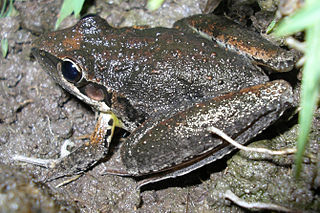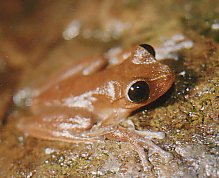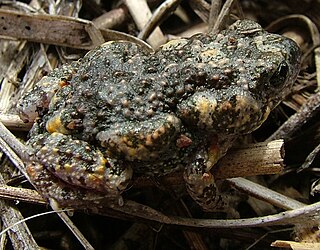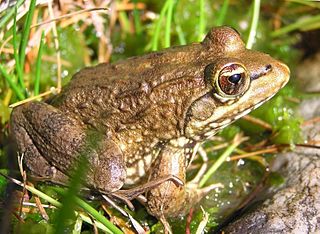
Ranoidea chloris, commonly known as the red-eyed tree frog or orange-eyed tree frog, is a species of tree frog native to eastern Australia; ranging from south of Sydney to Proserpine in mid-northern Queensland.

Tyler's tree frog or the southern laughing tree frog is an arboreal tree frog. It is native to eastern Australia. It occurs from southeast Queensland to the south coast of New South Wales. It is generally a coastal species and is not found inland.

The bleating tree frog, also known as Keferstein's tree frog, is a tree frog in the family Pelodryadidae. This frog is native to coastal eastern Australia, from south-eastern Queensland, to around Eden, New South Wales.

The barred frogs are a group of frogs in the genus Mixophyes. They are the largest of the Australian ground frogs, from the family Myobatrachidae.

The broad-palmed frog is a species of ground-dwelling tree frog. It is native to much of eastern Australia. They can be found from mid-Queensland to south of Sydney. It is associated with the coast and inland, and is distributed as far west in New South Wales to the SA border.

Freycinet's frog also commonly known as the wallum rocket frog, inhabits coastal areas from Fraser Island, Queensland, south to the Jervis Bay Territory of New South Wales.

The giant barred frog is a species of barred frog found in Australia. It occurs from south-eastern Queensland to just south of the Newcastle region in New South Wales. It is associated with flowing streams and creeks in wet sclerophyll and rainforest habitats from the coast to the ranges.

Fletcher's frog or sandpaper frog is a species of ground frog native to eastern Australia from South-east QLD to Ourimbah, NSW. It inhabits rainforest and wet sclerophyll forest of the coast and ranges.

The leaf green tree frog is a species of stream-dwelling frog, native to eastern Australia from the Queensland/New South Wales border south to Sydney.

Fleay's barred frog is a large species of frog restricted to small pockets of rainforest in northern New South Wales and south-eastern Queensland, Australia.

The stuttering frog is a large species of frog that inhabits temperate and sub-tropical rainforest and wet sclerophyll forest in Australia.

The Australian lace-lid is a tree frog endemic to the wet tropics of north-eastern Queensland, Australia.

The desert tree frog or little red tree frog is a tree frog native to Australia, southern New Guinea, and Timor. It is one of Australia's most widely distributed frogs, inhabiting northern Australia, including desert regions and much of temperate eastern Australia. It is one of the few Australian tree frogs to inhabit arid, tropical, and temperate climates.

The northern barred frog is a large, ground dwelling frog native to tropical northern Queensland, Australia.

The wrinkled toadlet is a species of small, ground-dwelling frog in the family Myobatrachidae It is endemic to Australia. It is also commonly called the small-headed toadlet, red-groined toadlet or the chubby gungan.
The streambank froglet or Flinders Ranges froglet is a small, locally common, Australian ground-dwelling frog, of the family Myobatrachidae.

The Cape river frog is a species of frog in the family Pyxicephalidae named for the Cape of Good Hope. Formerly, it was placed in the family Ranidae. It occurs widely in the Eastern Cape and Western Cape provinces of South Africa. A newly described species, A. poyntoni, was split from this species in 2013.
Meristogenys poecilus is a species of frog in the family Ranidae. It is endemic to Borneo and known from between central Sarawak (Malaysia) and central Kalimantan (Indonesia). The specific name poecilus is derived from the Greek poikolos, meaning "pied" or "blotched", in reference to diagnostic pattern on rear of the thigh. Common name Malaysian Borneo frog has been coined for this species.

The green frog is a species of frog native to eastern North America. The two subspecies are the bronze frog and the northern green frog.
The mottled barred frog is a species of large frog that is endemic to Australia. The specific epithet coggeri honours Professor Harold Cogger, formerly of the Australian Museum, for contributions to herpetology.




















